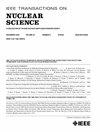直接数字射线照相用TlBr胶片
IF 1.9
3区 工程技术
Q3 ENGINEERING, ELECTRICAL & ELECTRONIC
引用次数: 0
摘要
将x射线强度转换成数字化电子信号并处理成图像的探测器,无论是用于医疗、研究还是工业应用,往往限制了现代x射线成像系统的性能。数字射线照相(DR)使用以下两种类型的探测器:1)间接探测器,其中闪烁薄膜将x射线转换成由光学探测器读取的光信号;2)使用半导体的直接探测器。半导体x射线探测器技术通常使用硅晶片、非晶硒(a- se)薄膜或相对较薄的碲化镉锌(CZT)晶体凸起连接到读出平台。尽管a- se和CZT的使用提高了硅的衰减系数,但性能的进一步提高对于改善高能量x射线(大于20 keV)的成像是非常可取的。本文介绍了溴化铊(TlBr)薄膜耦合到读出集成电路(ROIC)的研究结果。TlBr由于其高原子序数和高密度而成为硬x射线成像的一种有吸引力的材料,在CMOS ROIC上沉积1 cm ${}^{2} \ × 100$ $\mu $ m厚的柱状膜,其图像分辨率为20 $\mu $ m。本文章由计算机程序翻译,如有差异,请以英文原文为准。
TlBr Films for Direct Digital Radiography
The detector that converts X-ray intensity into a digitized electronic signal, processed into an image, often limits the performance of modern X-ray imaging systems, whether for medical, research, or industrial applications. Digital radiography (DR) uses the following two types of detectors: 1) indirect detectors, where a scintillating film converts X-rays into an optical signal read by an optical detector, and 2) direct detectors using semiconductors. Semiconductor X-ray detector technology typically uses a silicon wafer, an amorphous selenium (a-Se) film, or a relatively thin cadmium zinc telluride (CZT) crystal bump bonded to a readout platform. Although the use of a-Se and CZT improves the attenuation coefficient beyond that of silicon, a further increase in performance is highly desirable for improved imaging of higher-energy X-rays (greater than 20 keV). This article presents results on thallium bromide (TlBr) films coupled to a read-out integrated circuit (ROIC). TlBr, an attractive material for hard X-ray imaging due to its high atomic number and high density, achieves an image resolution of $20 \mu $ m as a 1 cm ${}^{2} \times 100$ - $\mu $ m-thick columnar film deposited on CMOS ROIC.
求助全文
通过发布文献求助,成功后即可免费获取论文全文。
去求助
来源期刊

IEEE Transactions on Nuclear Science
工程技术-工程:电子与电气
CiteScore
3.70
自引率
27.80%
发文量
314
审稿时长
6.2 months
期刊介绍:
The IEEE Transactions on Nuclear Science is a publication of the IEEE Nuclear and Plasma Sciences Society. It is viewed as the primary source of technical information in many of the areas it covers. As judged by JCR impact factor, TNS consistently ranks in the top five journals in the category of Nuclear Science & Technology. It has one of the higher immediacy indices, indicating that the information it publishes is viewed as timely, and has a relatively long citation half-life, indicating that the published information also is viewed as valuable for a number of years.
The IEEE Transactions on Nuclear Science is published bimonthly. Its scope includes all aspects of the theory and application of nuclear science and engineering. It focuses on instrumentation for the detection and measurement of ionizing radiation; particle accelerators and their controls; nuclear medicine and its application; effects of radiation on materials, components, and systems; reactor instrumentation and controls; and measurement of radiation in space.
 求助内容:
求助内容: 应助结果提醒方式:
应助结果提醒方式:


